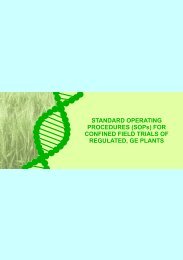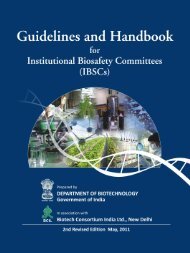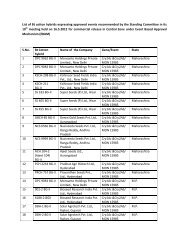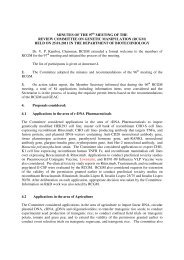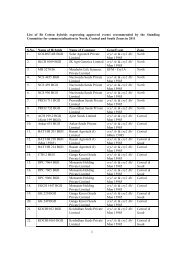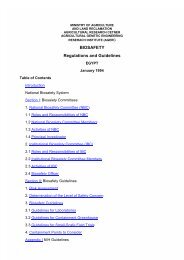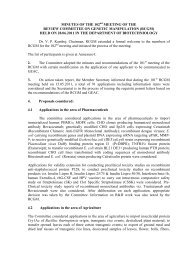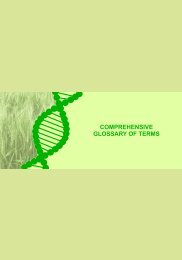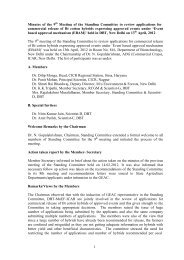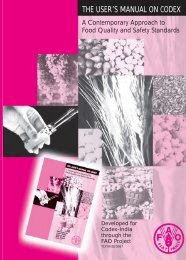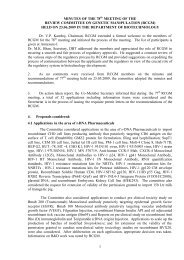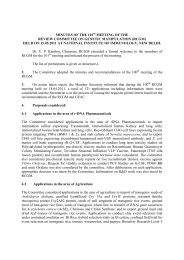Biosafety Guidelines For Research On Genetically Modified ...
Biosafety Guidelines For Research On Genetically Modified ...
Biosafety Guidelines For Research On Genetically Modified ...
You also want an ePaper? Increase the reach of your titles
YUMPU automatically turns print PDFs into web optimized ePapers that Google loves.
APPENDIX 3: INSTRUCTIONS FOR COMPLETING GMAC PROPOSAL FORMS<br />
AND ANNUAL REPORT BY IBC<br />
The Institutional <strong>Biosafety</strong> Committee will use the information provided in the GMAC<br />
‘Proposal <strong>For</strong>m for Assessment of Genetic Manipulation Work’ to determine the<br />
category into which the project fits and the containment level. GMAC will use the<br />
information in the form to assess proposals falling into Category A. In order to enable<br />
GMAC and the IBC to carry out those functions, a clear statement of what the<br />
applicant proposes to do is needed, and if this cannot easily be fitted into the space<br />
provided, a separate description shall be attached. The following suggestions are<br />
intended to ensure that GMAC has sufficient relevant information to make a prompt<br />
decision on the application.<br />
Title of Project and Aims<br />
When describing the aim of the proposal, include a brief description of the main steps<br />
involved. If both immediate and long term broader aims are included, make clear<br />
which component of the work needs IBC approval (or GMAC advice) now.<br />
If the project is complex and likely to take several years to complete, it will help if the<br />
work to be undertaken first is described separately. If recombinant DNA is ultimately to<br />
be inserted into whole animals or plants, or into bacteria not listed in Appendix 2 of<br />
these <strong>Guidelines</strong>, it may well be that approval can be given in the first instance for<br />
cloning and characterisation of specific genes or other DNA, with approval for later<br />
stages being possible only after such characterisation. If the stages are made clear to<br />
the Committee, approval or advice for the first stage may be given to enable the work<br />
to start.<br />
If the intention is to import biological material which falls under the <strong>Guidelines</strong>, the title<br />
may read ‘Intention to import...’.<br />
Source of DNA<br />
If the DNA has already been cloned, please give details of the construct: e.g. who<br />
made it, how it was made, and what is known of its properties.<br />
If several genes or species etc. are to be used, list all of them, because one proposal<br />
may cover them all. <strong>For</strong> example, if appropriate, request advice for chickens, ducks<br />
and other avian species. This will alleviate the need for repeated applications.<br />
Host Organism<br />
If more than one host is to be used, particularly if different containment levels apply,<br />
clarify when and how each is to be used. Comments made above on dividing a project<br />
into stages may be relevant. Please also complete the supplementary information form<br />
for experiments involving whole plants.<br />
Vectors<br />
Make the description for prokaryotic vectors as broad as is necessary to cover the<br />
intended work. <strong>For</strong> example, specify ‘non-conjugative plasmids such as pBR322 and<br />
pUC9’ if the project is likely to require a range of specific vectors as the project<br />
progresses. If only pBR322 and pUC9 are requested, the approval will be limited to<br />
the two vectors and will not cover the many closely related vectors which may turn out<br />
to be more useful.<br />
Appendix - Page 8



